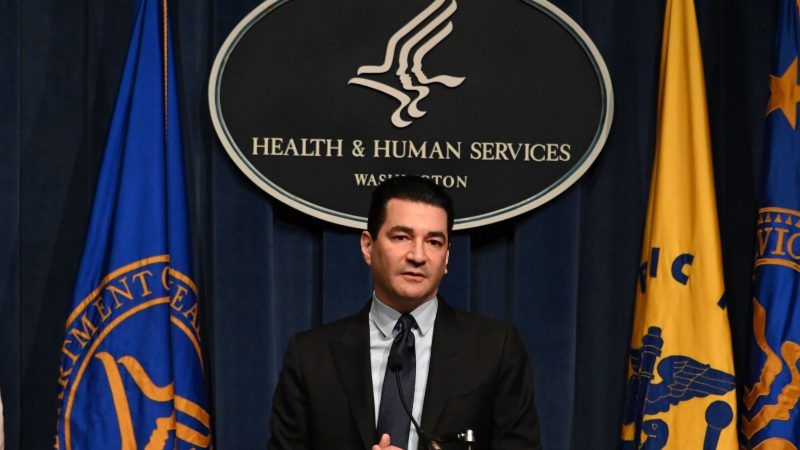The FDA Plans To Ban Flavored E-Cigarettes Based on a Nonexistent 'Epidemic' of Adolescent Nicotine Addiction
A new study indicates that heavy vaping remains rare among teenagers who don't smoke.

The main justification for state and federal bans on flavored e-cigarettes is the "epidemic" of underage vaping, which former Food and Drug Administration Commissioner Scott Gottlieb worried might result in "a whole generation of young people becoming addicted to nicotine." A new analysis of survey data on e-cigarette use by teenagers suggests such fears are overblown, since heavy vaping is rare among adolescents who are not current or former smokers.
The study, reported yesterday in the online journal Qeios, is based on 2017 and 2018 data from the National Youth Tobacco Survey (NYTS). Although it does not include results for this year, when e-cigarette use by teenagers rose again, the analysis demonstrates the fallacy of casually equating vaping with nicotine addiction.
Between 2017 and 2018, the prevalence of past-month e-cigarette use among high school students rose by 78 percent, from 11.7 percent to 20.8 percent. Last fall that surge prompted Gottlieb to propose new restrictions on the flavored e-cigarettes that are popular among teenagers, which are also overwhelmingly preferred by former smokers. Last month the FDA cited the continuation of the upward trend in underage vaping as the justification for the outright ban it plans to impose on e-cigarette flavors other than tobacco.
In the new study, University College London health psychologist Martin Jarvis and his co-authors argue that a closer look at the survey data suggests the FDA exaggerated the threat posed by adolescent e-cigarette use. While use on 20 or more days in the previous month rose between 2017 and 2018, it remained rare among students who had never used tobacco products ("never tobacco users").
"Frequent use occurred in 0.1% of never tobacco users in 2017 and 1.0% in 2018," Jarvis et al. report. "Among past-30-day e-cigarette users who had never tried tobacco products in 2018, 3.8% reported craving, 3.1% reported wanting to use within 30 minutes of waking, and 61.8% said they had used e-cigarettes on ≤10 days in their life."
In other words, it does not look like adolescent vaping is leading to the "epidemic of addiction" that Gottlieb predicted. "Data from the NYTS do not support claims of a new epidemic of nicotine addiction stemming from use of e-cigarettes, nor concerns that declines in youth tobacco addiction stand to be reversed after years of progress," Jarvis et al. write. "Among current e-cigarette users who had never tried tobacco products, responses consistently pointed to minimal dependence."
The story is quite different for tobacco users. "By comparison with never tobacco users, the odds of current e-cigarette use rose steeply and in a graded fashion with extent of tobacco experience," the researchers say. "Heavier use was strongly associated with lifetime tobacco use history….The observed frequency of 20+ days use [in the previous month] increased with the extent of lifetime tobacco use, and reached 26.8% in 2017 and 37.2% in 2018 among students who had smoked more than 100 cigarettes."
Tobacco users also were much more likely to report signs of addiction. Among "e-cigarette users with a lifetime history of smoking more than 100 cigarettes," 75 percent reported craving, while 51 percent said they wanted to vape within half an hour of waking up in the morning.
What about Gottlieb's concern that vaping might lead to smoking by teenagers who otherwise never would have used tobacco products? "It is notoriously problematic to draw inferences about direction of causality from cross-sectional data," Jarvis et al. note. "In principle, the strong and graded association observed between likelihood of using e-cigarettes in the past 30 days and lifetime history of use of tobacco products could point to an effect of using e-cigarettes on subsequent uptake and use of cigarettes and other combustible products. This appears to be the view adopted by the FDA."
But Jarvis and his co-authors argue that the evidence does not support the FDA's view:
While it may well be the case that in some individual instances initial trying of an e-cigarette led on to trying and using cigarettes, the data strongly suggest that this is not the dominant pattern observed at the level of the whole population. Among high school students we found that, for the great majority of those with any substantial cigarette smoking history, cigarettes were the first tobacco product tried, prior to any use of e-cigarettes. Clearly, for these students their use of cigarettes and the development of characteristic nicotine dependence must be attributed to cigarettes as the uptake product, rather than to e-cigarettes. Similarly, the observed rapid decline in trying combustible products and in the prevalence of cigarette smoking since 1999 has not yet given any sign of being reversed through the upsurge of e-cigarette use since 2011. At the population level, therefore, the NYTS fails to give evidence of e-cigarettes acting as a gateway to smoking in adolescents.
In fact, pre-2018 data from the NYTS and other surveys indicate that the downward trend in smoking accelerated among teenagers and young adults as e-cigarettes became more popular. Those trends suggests that people who would otherwise be smoking are instead vaping, a much less hazardous source of nicotine.
"Cigarette use generally declined between 2002 and 2018 across all age groups," the Substance Abuse and Mental Health Services Administration noted last August in a report on the 2018 National Survey on Drug Use and Health. "Some of this decline may reflect the use of electronic vaporizing devices ('vaping'), such as e-cigarettes, as a substitute for delivering nicotine."
Jarvis et al. think the weight of the evidence indicates that vaping is, on the whole, replacing smoking rather than promoting it. "In these circumstances," they say, "there is plausibility to the suggestion that e-cigarettes are likely to reduce the disease burden in the US by helping adult smokers to quit."


Show Comments (27)